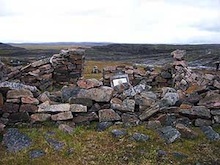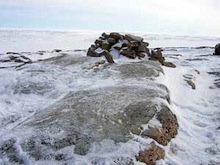In 1742, Christopher Middleton entered the Bay from Roe's Welcome Sound during his search for the Northwest Passage. He discovered that it was indeed a bay and not a passage and in his frustration at being blocked named it "Bay of Repulse".

It was not until much later that the area was visited by explorers of the Hudson's Bay Company. Most notable of these was Dr. John Rae. Setting out from Churchill in the summer of 1846, he and his crew landed at the mouth of the North Pole River, 24 kilometers west of present Repulse Bay. Quickly building a large stone house for "overwintering", he then set out by dog team to explore and map the uncharted Arctic Coast. In the process, Rae became the first European to explore the North using traditional Inuit methods. Actually, Rae and his party used the stone house only briefly. They found igloos far warmer and more comfortable. (for more information on Fort Hope at North Pole River and Dr. Rae's Stonehouse, go to Historical Sites)
The bay was also an important site for 19th century bowhead whaling with many ships overwintering on the Harbour Islands. These islands formed a circle and a perfect natural harbour within. The ships were primarily Scottish and British, unlike those of the New England whalers of Cape Fullerton, Depot Island and Marble Island. (for more information on the whaling history, go to Historical Sites)

As the bowhead whale stocks rapidly became depleted, the whalers were replaced by the fur traders of the Hudson's Bay Company; a post opened in 1921. In 1932, they were joined by missionaries of the Roman Catholic Church. The first public housing was built in the early 1960s and the present community was established. Government offices and a flurry of construction followed in 1968.